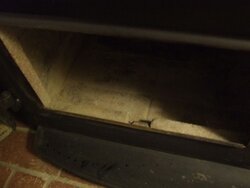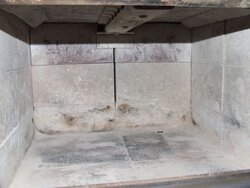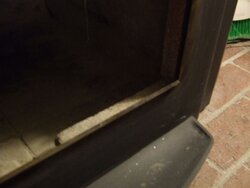I am hoping that all the fellow Napoleon 1402 owners can chime in on this... We have been using ours for the past month and now I have some questions. I apologize if any of these have been addressed in past threads, but I couldn't really find any when searching. So, here are my questions:
1. Glass keeps getting dirty. We have been burning hot fires (450F stovetop) and notice that there is still a distinct "V" shape pattern that develops on the glass door where the only clear part is the inside of the 'V'. Seems like I have to clean the door every other day. I can see the air wash when I open the door and small amounts of smoke develop and it is washed straight down. Wondering if it has to do with the placement of the two front firebricks? Those bricks have a cut out that allow them to fit around a metal piece that is in the middle along the front edge. Is it possible they have the wrong bricks? The manual only shows bricks numbered as 1 along the front and do not mention anything about it.
2. What is the correct loading method? north south or east west. (or doesn't it matter?) I watched a video that was suggested on another thread about the general usage of a wood stove and found it very informative, but wondered if there are any specifics to Napoleon. Again, their manual is very vague; I always like to get real world feedback.
3. Are we running it hot enough? Using the Rutland thermometer, we just stick it to the stove top in the middle and it seems to run between 350-450 when it's in the secondary burn after loading it with 5-6 splits. When it gets to 500 or 550 it seems to be too hot and according to the thermometer layout, thats reaching the too hot operational area.
...insert was professionally installed btw.
Well, that's about it for now. I really appreciate any comments from everyone who has been running one of these, even just explaining what someone's normal routine is. I still haven't gotten the guts up to do an overnight burn, but certainly want to once I feel confident that we are using this correctly. The forums have been great in finding information! Love the site!
>correction..the bricks along the front are labeled as "2" in the manual, but still don't represent anything with any type of cutout, just a rectangular brick. Also, the vertical bricks on either side of the door look like the factory took one brick and snapped it in two to create the bricks labeled as 8 & 9. Does anyone else see this in their own setup?
1. Glass keeps getting dirty. We have been burning hot fires (450F stovetop) and notice that there is still a distinct "V" shape pattern that develops on the glass door where the only clear part is the inside of the 'V'. Seems like I have to clean the door every other day. I can see the air wash when I open the door and small amounts of smoke develop and it is washed straight down. Wondering if it has to do with the placement of the two front firebricks? Those bricks have a cut out that allow them to fit around a metal piece that is in the middle along the front edge. Is it possible they have the wrong bricks? The manual only shows bricks numbered as 1 along the front and do not mention anything about it.
2. What is the correct loading method? north south or east west. (or doesn't it matter?) I watched a video that was suggested on another thread about the general usage of a wood stove and found it very informative, but wondered if there are any specifics to Napoleon. Again, their manual is very vague; I always like to get real world feedback.
3. Are we running it hot enough? Using the Rutland thermometer, we just stick it to the stove top in the middle and it seems to run between 350-450 when it's in the secondary burn after loading it with 5-6 splits. When it gets to 500 or 550 it seems to be too hot and according to the thermometer layout, thats reaching the too hot operational area.
...insert was professionally installed btw.
Well, that's about it for now. I really appreciate any comments from everyone who has been running one of these, even just explaining what someone's normal routine is. I still haven't gotten the guts up to do an overnight burn, but certainly want to once I feel confident that we are using this correctly. The forums have been great in finding information! Love the site!
>correction..the bricks along the front are labeled as "2" in the manual, but still don't represent anything with any type of cutout, just a rectangular brick. Also, the vertical bricks on either side of the door look like the factory took one brick and snapped it in two to create the bricks labeled as 8 & 9. Does anyone else see this in their own setup?


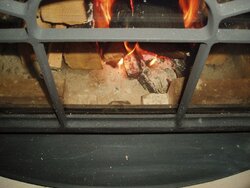
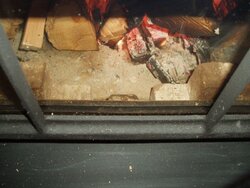
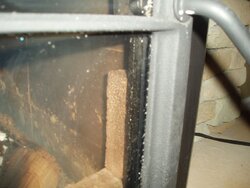
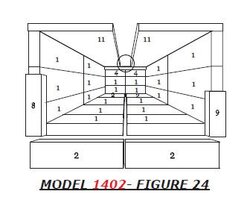
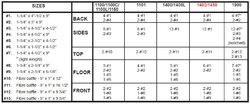
 .
. inside the notches. Now that they are at the top back, with the notches there to allow for the secondary air tube, I makes more sense now. Also, with the notched bricks in the front, they were too tall and that may account for the dirty glass people complain about.
inside the notches. Now that they are at the top back, with the notches there to allow for the secondary air tube, I makes more sense now. Also, with the notched bricks in the front, they were too tall and that may account for the dirty glass people complain about. 